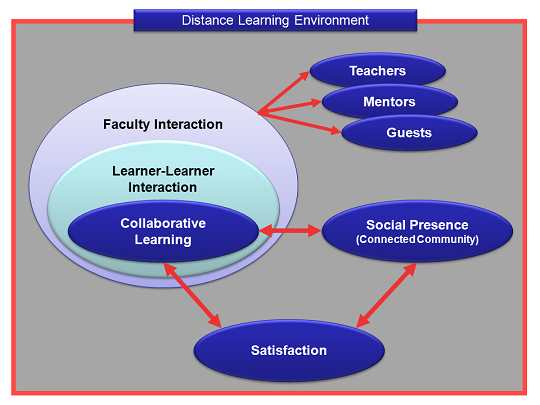Our Platform Concept: Infrastructure As an Adaptable Palette & Canvas
Our overall concept is to provide a turnkey system that is, in essence, a canvas on which any learning/teaching mission, objective or curriculum can be painted with any palette. It is complete and includes not only the technical platform itself but also the human talent necessary to operate and administer the total system. The turnkey system is fully implemented and ready to begin serving students and sponsoring organizations TODAY! It is extensible and can be adapted to the needs and curricula of any number of local control organizations.
Our concept is not intended to replace physical meetings and direct face-to-face involvement but, instead, use virtual technologies to embrace, extend and expand human contact and make limited human contact (typical of traditional church workshops) more frequent and more efficient.
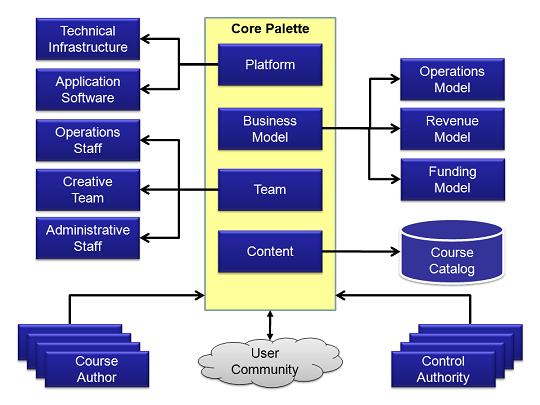
A "Common Bus" for Our Institutional Partners
We are a provider of “common bus” for technically-advance online education for our institutional partners that wish to conduct distance learning. We provide a complete technical and operational infrastructure for distance learning that is both curricula- and institutional-neutral. Into our infrastructure, learning modules (courses) from any number of independent organizations can be plugged without a significant (and redundant) investment on the part of our partners. Synergy is realized not only by the economy of a pre-built and pre-integrated platform but also from the community of online learners that we provide; all content partners benefit from the synergy resulting from the accreted pool of learners and communities. Our partners benefit from a larger pool of potential students than they would otherwise be able to attract on the own.
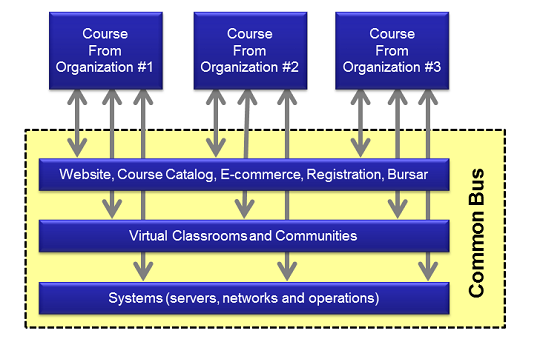
Business Model
Our business model assumes that we (TeleWorship and our content partners and associates) will invest all of the production, advertising, marketing and distribution costs for a course. Course authors (typically teachers/instructors) only have to bring their course ideas, outlines, and text content to us and we will assist them in the development and production of their ideas into a full online course. Course authors will provide their work and courses in exchange for royalty payments based on an agreement modeled closely after those of book publishing houses. We will market the course, sign up students, collect fees and pay royalties based on the revenue received.
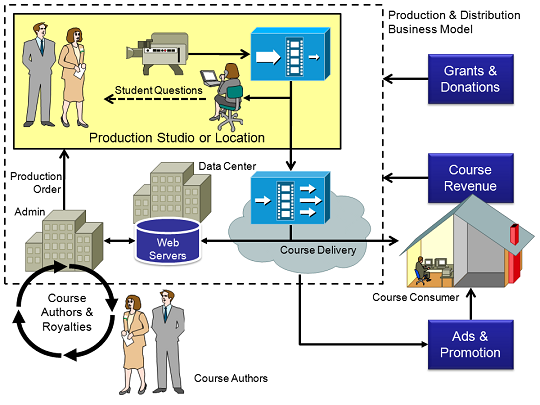
We will provide all of the investment into course development and production that will be recouped in the fees charged students to take the course when the course is placed on-line for sale. Additional grants and donations will be sought to provide the needed capital for course development. Also, funds will be sought to provide scholarships to students in need.
Alternatively, an institution, ministry, judicatory or consulting firm could sponsor a private co-labeled course by providing the course development expenses and, in turn, receive a higher royalty.
Quality Control
It is important that the quality of our courseware be very high; not only for its base content but the production values for how the course is delivered. Our courseware will not be "home-brew" productions, but professional produced to do justice to its content. If students are paying fees to take courses (and furnishing a significant revenue stream to fund the operations of this project), it is important we meet or beat the quality expectations of our student.
Also, and of great importance, the courses must work! They must provide teaching/learning that is useful to be merchantable.
The need for high quality standards is not just for aesthetics. Well-produced video with high production values has been demonstrated to hold students' attention longer and do a better job teaching its content to students.
Multi-Faceted Platform
The entire system is designed for multiple tenancies and all of the physical/logical systems can be partitioned to support any number of local control authorities (tenants) with any degree of overlap or complete independence from each other.
The entire system is also scalable and has been implemented using cloud-computing technologies that allow us to scale the capacity of the system as needed, even on a short-term basis. A minimal-cost configuration suitable for supporting thousands of unique visitors per day can be scaled up, on short notice, to support millions of unique visitors per day. Scaling of these magnitudes can happen with only five- to ten-minutes' notice. This type of rapid response is possible because of the design of the architecture of the system anticipated this need and the system's servers and network infrastructure reside in large-scale professional data centers that provide this type of physical infrastructure scaling on very short notice. We also assume that these types of scaling requirements might be episodic and last for only several days at a time. Therefore, it is possible to scale up the capacity of the system to meet a short-term need and then scale back to the more typical system loading for more economical operations. We only have to pay for the increased capacity when it is needed. Overall, this capability provides a very flexible "dial-a-capacity" feature to meet any circumstance that might present itself without the burden of over-building capacity not needed in normal operations.
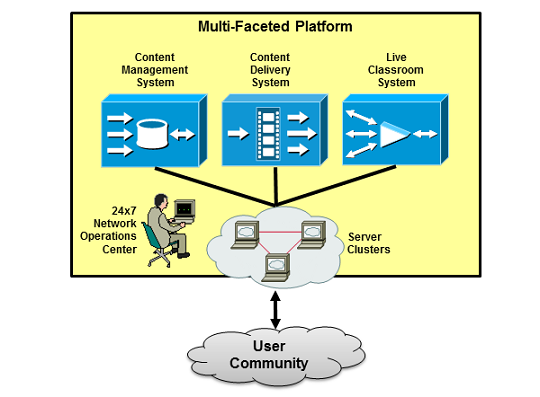
TeleWorship Content Management System
The TeleWorship Content Management System (CMS) is an advanced computer application that is implemented as a web-based cloud-based hosted service that is used to create, edit, manage, search and publish web pages and various kinds of digital media and interactive objects. It is used to manage and control a large, dynamic collection of Web material (media, interactive objects, HTML documents and their associated images and files); it facilitates content creation, content control, editing, and many essential Web maintenance functions.
The TeleWorship CMS uses a data base to store content, metadata, and/or other data that is needed by the system to create complete web pages.
The TeleWorship CMS has a presentation layer that extracts all of the content elements from the data base and displays the content to regular website visitors based on a set of Page Styles and Theme Files that function as templates.
The TeleWorship CMS provides a rich text editor as an authoring tool that, when used with other features of the CMS, allows users with little or no knowledge of programming languages or markup languages to create and manage content with relative ease.
Administration is performed completely through browser-based interfaces.
TeleWorship Content Delivery Network
Media, including audio, video, rich media and interactive Flash objects, are very important components of any successful online learning system. Online learning systems by their very nature are media-rich environments that provide a rich source of content for the learning/teaching environment. The ability to integrate this type of media into web pages and efficiently serve both live and on-demand media is a basic requirement.
Also, the students of an online learning system have high expectations about how media are served; video needs to have high spatial resolutions and frame rates. Audio must be clear and high fidelity. Both video and audio must be served without packet loss, excessive buffering or stream interruptions.
In order to store and serve large amounts of high-quality media, TeleWorship provides the TeleWorship Content Delivery Network (CDN).
The TeleWorship CDN is a specialized platform for the delivery of live and on-demand media such as audio and video consisting of:
- Specialized storage arrays for media files;
- Specialized media servers for providing large numbers of live or on-demand streams;
- Specialized network connections and routing to minimize latency and particularly jitter to end users.
The TeleWorship CDN is entirely cloud-based and essentially a system of storage arrays and media servers that are strategically networked at locations across the Internet using advanced routing and switching protocols that cooperate transparently to deliver media content to end users. Its specialized design is for the purpose of improving performance, scalability, and cost efficiency when serving large volumes of media.
When each individual user requests to view a video, the content delivery network determines which of the CDN's node locations would best serve the end user requesting the video. Currently, the CDN can choose any of our 53 node locations from all over the world. Once the serving node is selected, the CDN downloads the video to the serving node (at multi-gigabit-per-second core network speeds). The video files get cached in the node from our storage cloud and play them out to the end user requesting to see the video. The video files will live in the cache for 24 hours to serve any re-play to the original requesting user and any other nearby user that come during the 24-hour period. This feature allows us to serve a large portion of the population of the planet as if they were all local.
TeleWorship Live Classroom
The TeleWorship Live Classroom (TLC) creates any number of live real-time synchronous online classrooms or virtual meeting rooms for web conferences. These are professional environments that can be used to teach live over the Internet. Also, the TLC can be used to create easy-to-use web conference rooms for unlimited web meetings and webinars. You can share online presentations (PowerPoint slides), whiteboards, audio, video and share screen, files and web cam. All functions take place over the Web in real time. You only need a computer with an Internet connection for your live sessions.
The TLC can create individual student profiles, giving a personal username/password to each student and assign individual or group class attendance. The system also maintains a personal calendar of classes and events for each user.
User experiences with the TLC are powered by a rich set of collaboration tools available in each virtual classroom and meeting room.
Multi-Faceted Website
The primary means for student to interact with our organization will be through an advanced multi-faceted website. This website will provide all pre-sales and free functions as well as provide the virtual campus for our learning community for students, ex-students, faculty and staff.
In addition to providing public web pages, the website will feature a User Management System that provides access control for authorities and permissions. The User Management System will allow us to provide Membership and Private Areas of the website. The User Management System is also integrated with our e-commerce features and its workflows so that access permissions can be vended in a totally automated way for fee-based content.
This password-protected Connected Community is the central component to the whole website and serves as our virtual campus, Student Union Building and common room for both students and faculty. All students who subscribe to any distance learning course or free event will automatically be granted access to the Connected Community member portal.
The centerpiece of the Connected Community member portal will (1) function as the entrance gateway for all classes, private communities and private consulting rooms; and (2) host all of our Connected Community social computing features and functions for current and former students. Current and former students will typically return to the Connected Community member portal weekly, if not daily.
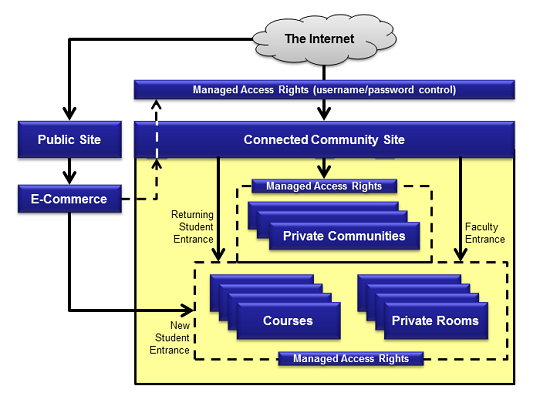
Automated Bursar/Registrar Functions
Our system provides fully-automated bursar and registrar functions what operate without supervisor intervention needed 24x7.
Course can be vended in a totally automated fashion with students paying by debit card, credit card, gift card or even by invoice. Scholarship codes and special offer codes are also supported for providing full or partial scholarship or providing discounts for group/bulk purchases.
Our system automatically maintains a dynamic catalog that functions as our “Course Catalog” for all active and available courses, their unique workflows and business rules. The dynamically-built Course Catalog can also highlight any new or featured courses. These functions are the centerpiece of our powerful e-commerce engine that automates both the traditional bursar and registrar functions.
Students select the course they wish to purchase from the course catalog, apply any scholarship or offer codes, check out and pay through our integrated and secure e-commerce system
The system allows us to provide special offers such as partial or full scholarships or discounts for multiple purchases and/or group purchases by pre-defining all of the business rules for a special offer. Unique special offer codes can be assigned to qualified individuals or groups. We can support an unlimited number of special offers.
Upon successful financial settlement with our system, the student is provisioned into both the class roster for the class they purchased and the Member Portal (our virtual campus).
Class Folders
The Member Portal is also the main entrance for each class we offer. Each distance learning course and all of its supporting applications and documents will reside in its own unique private Class Folder. The entire Class Folder structure is secure; anyone who attempts to access any of its pages, applications, documents or media is first authenticated and their authorization permissions are checked. Media display objects are digitally signed and media will not be displayed from the media servers unless it is served to a validated and authenticated media display object.
These efforts not only secure the contents of a Class Folder, they also limit access to all of the materials to properly authorized users.
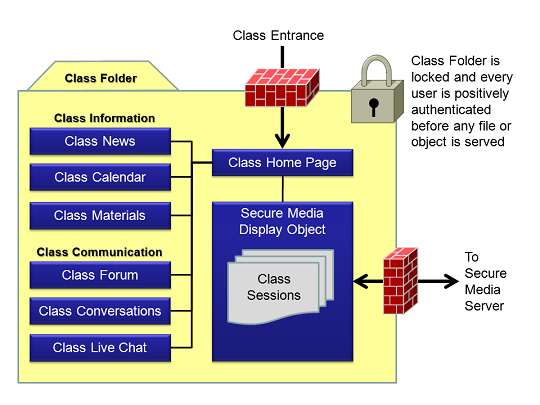
Access to the Class Folder is managed automatically by the system and access will be limited to paid (or scholarship) students, authorized mentors/teaching assistants and faculty/instructors. All Admission, Registrar and Bursar functions are full automated and operate 24x7 without the need for supervisor intervention. Students register for classes using a credit/debit card, a TeleWorship Gift-of-Education Card or a special Offer Code (Scholarship Code). Offer Codes can be used to provide special discounts, partial or full scholarships.
Upon successful real-time financial settlement, students are instantly admitted to their Class Folder and can begin the course immediately. At the same time, the student is also granted access to the Member Portal for one year (365 days.) Since each course resides in its own Class Folder and access is limited to only those classes to which the student is registered. Access to each Class Folder is typically limited to a published duration of the class. However, each class can have its own unique duration and is determined by the course instructor.
All of the registered students of each class make up their own social community within the class, albeit a subset of the whole membership of the site. Therefore a student can belong to a community based on each class PLUS the larger total community of the Member Portal thus reflecting a relationship model that is analogous to any university.
Dual-Path Two-Way Communication
To be true distance learning (and not just educational television) students need pathways to interact with instructors and mentors at a distance. The TeleWorship Distance Learning System provides these pathways.
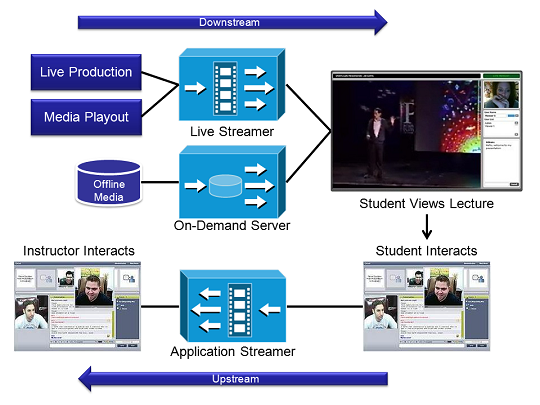
Residing with the Class Folder, there are applications that provide both downstream channels to the students as well as upstream channels that function as return paths allow each student to interact with instructors and mentors.
Downstream channels provide high-quality media:
- Live
- Prerecorded but played out as if live
- Prerecorded and served on demand
Upstream channels (the return path) proved:
- Live text chat
- Live video chat
- Voice channels
- Class forums
- Private conversations
Pedagogy
The communication features of our distance-learning system yield highly-interactive environments for collaborative learning. Faculty can easily interact with students and guide student-to-student and student-to-mentor/guest discussions for formal and ad-hoc collaborations.
Our system supports just about any pedagogy that any of our teachers/instructors might wish to use in the development of an online course.
We also have a tested baseline pedagogy that we recommend based on our past experience with high-quality distance learning that produces highly-interactive collaborative learning. We can use our baseline pedagogy or develop another, using standard tools within our system that matches the teaching/learning theories desired by our teachers/instructors.
